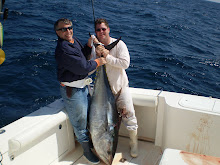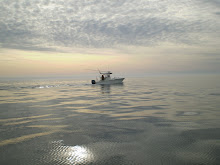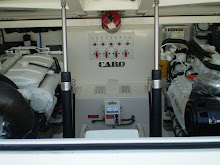
Funny how ironic life can be: one day you talk about doing something with a fishing partner (specifically, Dan), and what appears the very next day in a fishing magazine--purchased impulsively to kill time on a flight from San Francisco to Dulles--but an article about four guys doing the same thing, except down in the Florida Keys as opposed to North Carolina! Clearly, the article's chance appearance--no doubt about it--is a sign from the Fishing God that our version of the trip is "meant to be," indeed "pre-ordained," if you will. And who would want to go against this God's wishes and risk an eternity in hell--meaning, in this case, an endless chain of fishing trips all ending with the skunk.
Read the article below carefully, Dan, and get your mental wheels in gear. (Note: their trip took place in September 2010; photos at the end of the text.)(Note: a special thank you to Sport Fishing magazine.
2010: A Skiff Odyssey
How four guys in two boats fished the Florida Keys in four days
Jan 20, 2011
By Adrian E. Gray

As I held NOAA chart No. 11450 in my hands last September, I could hardly fathom that the series of pen markings from Miami to Key West and back revealed that we had boated 415 miles in four days' time. I found it even more mind-boggling that we traversed every single mile in two skiffs.
My Cape Canaveral-based friends Derek Redwine, Tyler Shealey, Chris "Bootsy" Wilson and I had cracked open the shell of everyday life to follow our yearning for adventure by circumnavigating — and fishing — the Florida Keys by skiff. We let our instincts and passion to explore lead the way, but we carried paper charts, aerial photos and tide tables, which had helped us choose in advance which locations to fish. We outfitted an 18-foot-8-inch Hell's Bay Neptune and an equally seaworthy Chittum Islamorada 18 as the platforms for our exploreathon.
However, the National Weather Service forecast 15- to 20-knot southeast winds the day before our departure. We wondered: "Should we do it? Is it wise to go?" With "the safety in numbers" philosophy and only 12 hours to spare, we agreed to go for it and meet in Miami at 7 a.m. the next day.
Day One: Key Biscayne to Islamorada
6 a.m.: Derek called me: "Tyler slept in, we're leaving Merritt Island now." Brief silence. "Kiiidding! We are an hour away, passing through Palm Beach."
I towed the second skiff from Fort Lauderdale to Gordon's Bait and Tackle in Miami (305-856-4665), a convenient place to buy bait early in the morning, and then met the others at Crandon Park Marina.
We felt some anxiety about leaving our vehicles and trailers at the ramp for four days, but with 24-hour security at the marina, we decided to take the risk. (Ramp parking costs $12 weekdays; $15 a day for weekends/holidays.)
8:30 a.m.: We spent two hours organizing gear, officially documenting our departure at 10:30. We calculated our plan: Eight hours of available daylight, traveling 85 miles to Islamorada and averaging 30 mph would leave us about three hours of running and five hours of fishing time.
We couldn't account for potential weather delays, but Tyler could pull up the local radar on his iPhone as long as he was near shore. So he became the "Shealey-Weather-Genie."
11 a.m.: We ran to the shoals of Biscayne Bay's Stiltsville and poled past the silhouettes of seven remaining houses. Calm conditions seemed to contradict recent advisories, but we could see towering dark clouds moving our way from Homestead.
With foul weather looming and unproductive slack-low-tide conditions, we pressed south into the Upper Keys. When we veered around Christmas Point into Caesar's Creek, the storms passed behind us and the tide began rising. At the creek's Hurricane and Rubicon flats, we saw permit.
One of Derek's bull's-eye casts to a school of five lay rejected at first, but two fish whisked around to circle the crab again and then beelined it to a nearby channel. "Psyyyyche!" I said, while Derek still held the rod up high, maybe hoping his kamikaze crab might swim after the permit.
We fished for an hour. Tyler caught a bonefish. Derek hooked a scrappy bonnethead shark — his consolation prize.
1 p.m.: Winds picked up to 20 knots from the southeast. Poling the flats from the Ocean Reef Club to Pennekamp State Park in Key Largo became a less-than-electrifying plan of attack. Instead, we stopped randomly along the way and drifted, peppering 3- to 4-foot-deep grass flats with artificial lures. Tube lures out-produced Zara Spooks and spoons on 2- to 3-foot barracudas, but the detonation of each missed topwater strike zeroed out the scorekeeping.
4 p.m.: At Tavernier Key, we detoured to the Gulf side through Tavernier Creek to run the leeward waters to Islamorada. A few miles south of the creek, a communications tower marked the location of Islamorada Fish Company, the perfect place for four anglers jonesing for pints of barley pop and cheeseburgers.
6:30 p.m.: We pulled in at Bud N' Mary's Marina (305-664-2461, www.budnmarys.com) and met with owner Richard Stanczyk. We had reserved a houseboat, but Stanzyck graciously upgraded us to a gorgeous three-bedroom beach cottage, complete with 25 feet of dock for both skiffs.
Day Two: Circumnavigating Key West
5 a.m.: "What do red, yellow and green stand for?" I asked Derek while shaking him awake. "Huh? What's happening? Apples?" he groaned.
"Nope, not apples," I said. "It stands for 40-mile-per-hour winds and rain." The weather outside was howling, and those colors on my iPhone's radar image meant another hour of listening to loud snores.
By 7:30, a heavy caffeine buzz mixed with the background noise from obnoxious TV ads was distressing enough to make a cat swim laps. So we ventured through the storm to the Lorelei (305-664-2692, www.loreleifloridakeys.com) for the outstanding biscuits and sausage gravy.
An hour later, a few sun rays peeked through the clouds. "Gotta love Florida weather," Chris said. "One minute, it looks like the reincarnation of Hurricane Andrew and the next, pure paradise."
9 a.m.: Skimming over liquid glass.
9:30 a.m.: We found a slack-high tide at the Channel Two Bridge. Looking into the clear depths below, Derek waggled his first two fingers in a peace sign — the scuba diver's universal indicator for lobster. "I've always wanted to catch a lobster," Tyler said. Ten minutes later, Tyler had his wish.
10 a.m.: The Long Key State Park flats, with its roving sharks and rays, looked too good to pass. Derek and Chris stood on the casting platforms armed with 8weight fly rods and small toad flies.
Sighting a dozen bonefish in a half-hour gave us heart murmurs, but the fish remained out of range. Derek plucked a jack crevalle off the back of a ray for some excitement.
11:30 a.m.: We interrupted 20 miles of smooth running past Duck and Grassy keys with a refueling stop at Captain Hook's on the south side of Vaca Cut (305-743-2444, www.captainhooks.com).
"You think we can make it to Key West today? It's not even noon, and according to the GPS we're 50 miles from Southernmost Point," Derek said.
"Not before we catch a permit at Pigeon Key," I replied. "Then we can forge ahead."
12:15 p.m.: Call me clairvoyant. Derek poled into a strong current exiting the Gulf side over Pigeon Key Bank. Among the many turquoise pot holes on the edge of the lush flat, a 15-pound permit fell victim to my crab.
2:30 p.m.: Derek and I were on cloud nine. The adrenaline from the catch, added to warmth from the tropical sun, put us in a Key West state of mind. "A two-hour run should put us there around 5 p.m., enough time to get settled before we hit Duval Street," Derek said.
4:30 p.m.: We stopped to pole a broad flats basin between Saddlebunch and Pelican keys. Small lemon sharks chasing mullet wrinkled the calm water around us, but we had no luck fishing the hot, low water.
6 p.m.: Approaching Key West's Southernmost Point from the water differs considerably from walking up to the land marker amid groups of shutter-happy tourists. We could also look back at the 160-mile run from Miami and know that the return trip was more achievable than we'd thought.
Tyler called his friend Bear Holeman, a Key West guide who had generously offered us local intel. He said that fishing had been quiet on the ocean side, and that if permit and tarpon were our game, then we'd better cancel our Duval plans and boogie up to Big Spanish Cay.
We took his advice, and with the help of the GPS, we headed around to Big Pine on the Gulf side. Along the way, Derek called his good friend and noted TV host Jose Wejebe, who lives in Summerland Key, for advice about hotels with waterside dockage. Jose suggested Palmer's Resort in Big Pine (305-872-2157, www.palmersresort.com), but when he unexpectedly offered for us to stay at his house, we jumped at the chance.
Day Three: Summerland Key to Islamorada
8 a.m.: We stopped at Chevron Island Auto & Marine (305-744-9717) on Summerland Key for fuel and to refill our livewells. Across the parking lot, we sampled the biscuits and gravy at the Galley Grill (305-745-3446).
5 p.m.: We fished almost all day from Mayo Cay to Big Spanish Cay and Spanish Bank. Derek pitched quarter-size crabs on spin tackle; Chris tossed a Merkin on his 10-weight fly rod. They intended to hook permit, but passing tarpon made short work of their 30-pound shock leaders.
On the mental fish scale, seeing and hooking outweighed landings, but we apparently were paying dues for the show Mother Nature was about to present.
5:30 p.m.: We floated over white, marly sand off the labyrinthine Content Keys north of Big Pine, Summerland and Sugarloaf keys. The sun was two hours away from kissing the horizon, and the water's surface had morphed to a reflective sheen like liquid mercury.
Although our polarized lenses proved useless looking into the water, we saw the black sickle shape of permit dorsal fins and the fidgety wakes of bonefish. The creatures of the flats had roused as the lunar forces began steering water back to our side of the planet. A one-hour period gave Chris a permit on fly and two bonefish between Tyler and Derek.
6:30 p.m.: On the 40-mile run back to Islamorada, nature bestowed one of the grandest sunsets we'd ever seen. We arrived at Bud N' Mary's in the dark, but were just in time for delicious coconut-crusted grouper sandwiches at Lazy Days Restaurant (305-664-5256, www.lazydayssouth.com) next door.
Day Four: Islamorada to Key Biscayne
6 a.m.: An early exit put us on Islamorada's Gulf flats in greasy, calm conditions. At Lignumvitae Channel, Tyler and Chris caught sight of two permit and a 100pound tarpon working down the edge. After three failed opportunities there and two encounters with stuck-up bonefish on Peterson Key Bank, we ran farther into the Gulf to fish Rabbit Key on Nine Mile Bank.
8:30 a.m.: We had bonefish in mind at Rabbit, but a school of redfish surprised us. Derek unleashed his 6weight fly rod with a rust-colored Borski Slider and had no problem enticing a red. Chris and Tyler also caught two reds on crabs.
10 a.m.: We returned to Islamorada, refueled at Worldwide Sportsman and purchased more bait for the Key Largo to Biscayne Bay leg. By that time, the wind had increased from a light-and-variable puff to a sustained 15knot breeze from the northeast.
1 p.m.: Storm cells brewed over the Everglades. Conscious of safety, we stabbed our bows into a tight, 2foot chop to make good headway through Key Largo's Baker Cut into Buttonwood Sound.
Idling through Grouper and Dunsbury creeks provided some reprieve from the steady wind, but it was short-lived when we entered Blackwater Sound. Along the north shore, the prominent, new 18-Mile Stretch Overpass clearly marked Gilbert's Resort and entrance to Jewfish Creek. We tied up at Gilbert's for a powwow.
"I don't like the look of that," Tyler said pointing north. "The radar tells me those storm cells extend from downtown Miami all the way to Homestead, and they're moving over Biscayne." We made the decision to cover the next 15 miles as fast as we could through Barnes and Card sounds, passing under Card Sound Bridge to reach Broad Creek.
3:30 p.m.: We had avoided the rain, and to the north, Old Rhodes Key blocked the wind from Cutter Bank to some extent. Our vision was best poling into the wind, and it didn't take long to see our first school of bonefish.
Derek closed the last chapter of our angling adventure with a small bonefish. Only a leader length from the skiff, the fish ate a fly at the eastern fringe of Cutter Bank.
5:40 p.m.: The last 25 miles heading home rocked our small skiffs. It was a welcome sight to see our vehicles at the Crandon boat ramp, just as we had left them.
***
What to Bring
Tackle:
- Two 7-foot-6-inch, light-medium spinning rods with 10-pound PowerPro on Shimano Sustain 4000s for pitching light jigs and shrimp.
- For tarpon (up to 60 pounds) and permit, two 7-foot, medium-heavy spinning rods with 15-pound PowerPro on Shimano Sustain 5000s — kept locked and loaded nearby with a live crab dangling in the water.
- Three fly rods — 6-, 8- and 10-weights — with appropriate flies and species-specific leaders.
- Two Shimano Tyrnos 16 conventional reels with 50-pound PowerPro, medium-heavy 6-foot-6-inch Trevala rods for tugging on goliath grouper and larger sharks.
- Short- and long-shank hooks, sizes 2, 1, 1/0 and 2/0 for mangrove snappers, permit, tarpon and bones — plus, 7/0 to 9/0 circle hooks for big baits.
- Monofilament leader from 10- through 100pound. Malin stainless No. 4 wire for barracudas; doubled and twisted for sharks.
- Artificial lures: D.O.A. Shrimp and TerrorEyz, jigs with soft plastics and Gulps!, plugs, spoons and tube lures.
Other helpful gear:
- Besides keeping a GPS on board, print out satellite images from Google Earth (www.google.com/earth). Print the screen images from your computer and use a binder with plastic sleeves to organize the images according to the direction you'll be heading.
- A Wi-Fi-enabled cell phone that can pull up the latest weather radar. Bookmark www.radar.weather.gov into favorites.
- Insect repellent!
- Lightweight clothes that dry fast when washed with hand soap. Long-sleeve shirts, long pants, buff headwear and a hat, as well as SPF 30 sunscreen.
Gasoline needs:
- 18-foot-8-inch skiff powered by 115 hp two-stroke Evinrude EFI
- Total fuel cost = $307.60
- 415 miles/81.2 gallons = 5.1 mpg
- 18-foot skiff powered by 60 hp four-stroke Suzuki
- Total fuel cost = $192.70
- 415 miles/50.5 gallons = 8.2 mpg


















